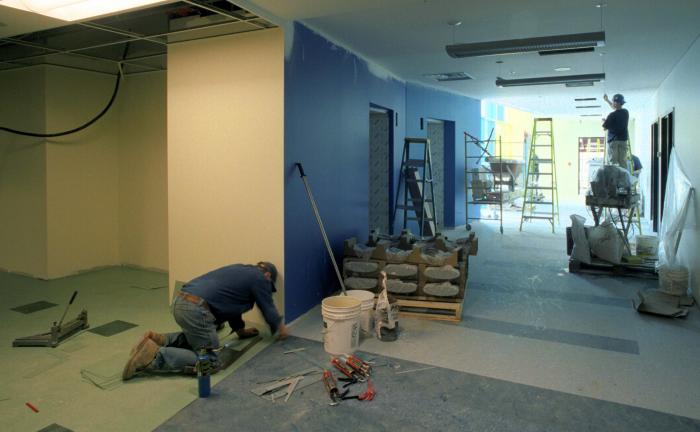
About
Ask yourself...
- Do you like working indoors?
- Are you strong and physically fit?
- Do you have an eye for colour?
- Are you good at measuring things?
- Do you like working with your hands?
If the answer to these questions is yes, then a career as a Floor Covering Installer could be right for you.
Floor covering installers install carpet, wood, linoleum, vinyl and other resilient floor coverings in residential, commercial, industrial and institutional buildings. They are employed by construction companies, floor-covering contractors, installation companies and carpet retailers, or they may be self-employed.
Duties
As a Floor Covering Installer, your duties may include the following:
- Installing carpeting, hardwood floors, trims and bases to floors or other surfaces
- Inspecting, measuring and preparing surfaces to be covered
- Inspecting and repairing damaged floor coverings
- Estimating material and labour costs
Work Conditions
The standard work week for floor covering installers is 40 hours (8 hours a day, 5 days a week). As with many careers in construction, there are peak periods that will require you to work overtime. The number of additional hours you work each week depends on the construction sector and region you work in, and will vary from one job to the next. You may have to work occasional nights when renovating offices or other public buildings that are occupied.
As a Floor Covering Installer, you will work mostly indoors, usually with a team of other workers. The job is physically demanding and often involves lifting heavy materials and kneeling for long periods of time.
As with all careers in the construction industry, safety is the top priority. Floor covering installers are trained to work safely and take special precautions to protect against injury.
Training and Certification
Apprenticeship
Apprenticeship involves both classroom studies and on-the-job training under the supervision of a certified Floor Covering Installer, called a journeyperson.
As an apprentice, you earn while you learn and are paid by the hour while working on the job site. Wages start at about 50 per cent of a journeyperson’s hourly rate and increase during your apprenticeship until you reach the full rate.
Entering an apprenticeship program
Requirements for floor covering installer apprenticeship programs vary across Canada. In most provinces and territories, you must have a Grade 9 education or equivalent to enter a floor covering installer apprenticeship program. You may find it helpful to have courses in drafting and mechanical drawing, math and shop.
Some provinces and territories offer secondary school apprenticeship programs that allow high school students to work towards a career as a Floor Covering Installer.
For more information, check out the apprenticeship section.
Program length
Apprenticeship training programs for floor covering installers vary across Canada, but generally involve three 12-month periods, including at least 4,400 hours of on-the-job training, two six-week blocks of technical training and a final certificate exam.
Related work experience or completion of a floor covering installer program at a college or technical institute can reduce the time required to complete your apprenticeship.
Certification
Certification is required in Quebec, and is available but voluntary in Alberta, British Columbia, Manitoba, New Brunswick, Newfoundland and Labrador, the Northwest Territories, Nova Scotia, Prince Edward Island and Saskatchewan. Where certification is not available, it may be possible to study as an apprentice through your local labour organization. Check out our Related links to find out who to contact. Even where certification is voluntary, it is still recommended. Certification tells employers and other workers that you are a skilled professional. It also helps you get jobs.
To be certified as a Floor Covering Installer, you usually need to complete a two- to three-year apprenticeship program. Once you successfully complete the required on-the-job training, technical training and exams, you are awarded a journeyperson certificate.
You may be eligible for certification in some provinces and territories if you have more than three years of on-the-job experience and some high school, college or industry courses in floor covering.
As a certified Floor Covering Installer you may write the Interprovincial Exam to qualify for the Interprovincial Standards’ Red Seal. With a Red Seal, you can work as a Floor Covering Installer anywhere in Canada.
To keep their skills current, Floor Covering Installers must keep up with new technologies by reading and speaking with others in their field.
Courses
Anticipated In-Demand Regions
- British Columbia
- Nova Scotia
- Ontario - Eastern Region
- Ontario - Northern Region
Wage
 | ||
| Mid range $45,070 |  | High range $72,800 |
The “mid range” wage is based on the national “median” wage reported in the Job Bank career profile for this National Occupational Category (NOC): 7295
Note: Some career profiles may have more than one NOC code associated with them.






